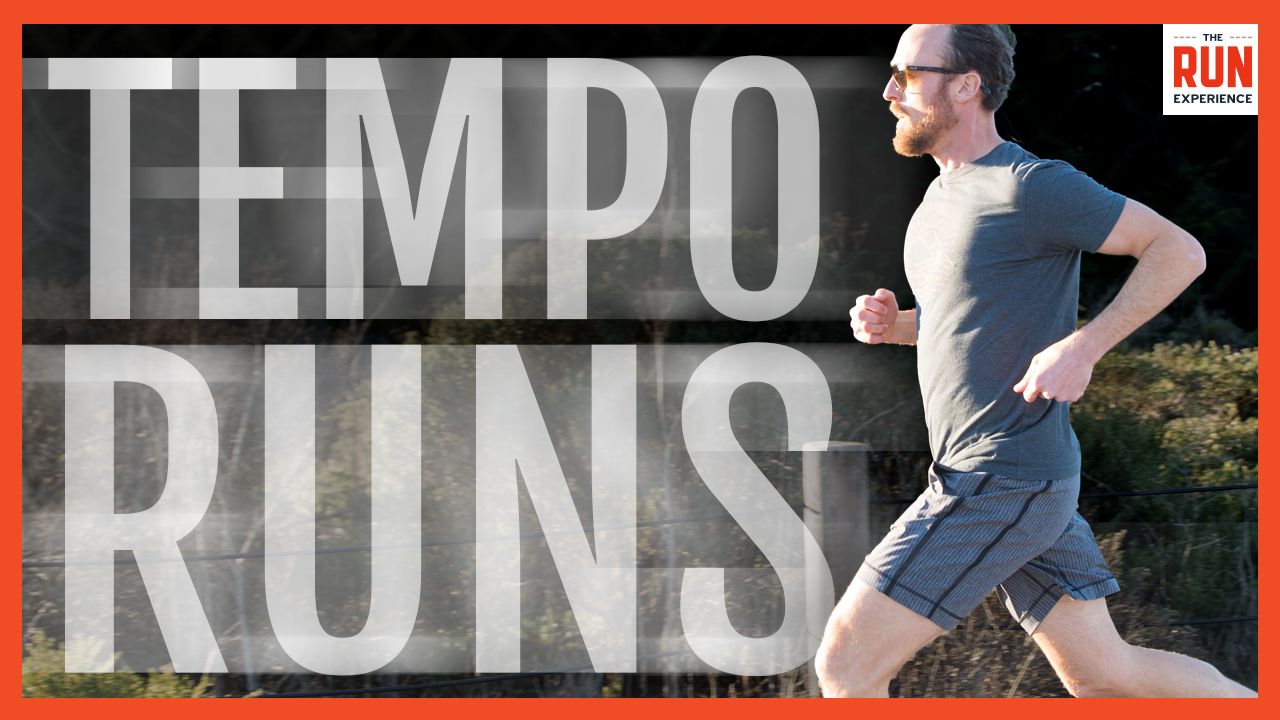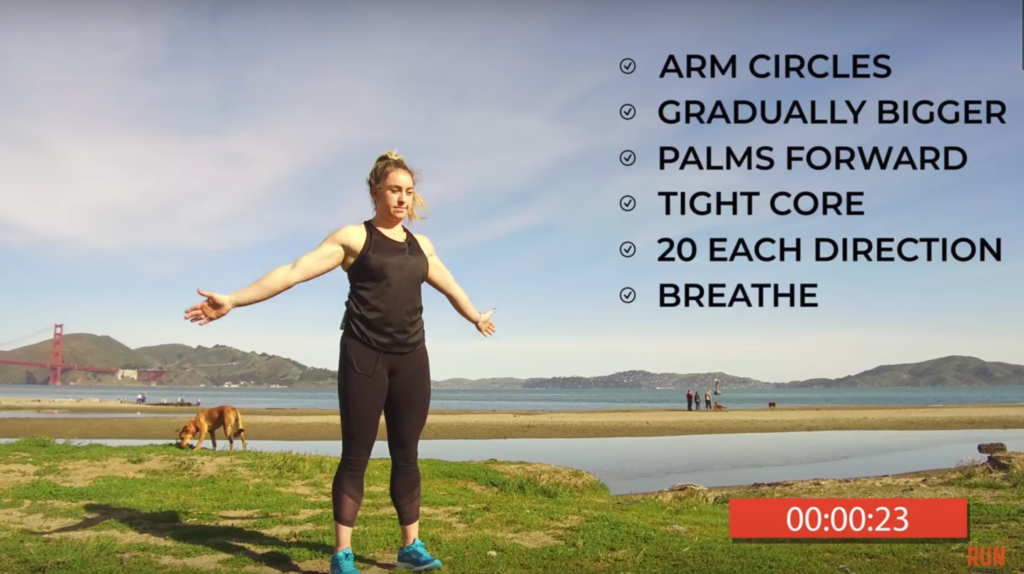Tempo Run: What Is a Tempo Run (and Why You Need It)
What is a tempo run? Why should every runner should include a tempo run in their schedule? Learn how this training run can boost performance!

What are tempo runs? If you’ve never heard of a tempo run before, don’t fret! We’ve got the details all lined up for you!
Below, we’ll walk you through:
- What is a tempo run
- Tempo running pace
- How to do tempo runs (the right way)
- How to add tempo training to your routine
- Sample tempo run workouts
What is a tempo run?
Tempo running is a type of speed workout. This type of workout falls in the same category as fartlek and interval workouts, though those two serve different purposes.
Generally speaking, a tempo run is a sustained effort run that builds up your body’s ability to run faster for longer periods of time, no matter if you’re training for a 5k or a half marathon.

Typically you would find a pace that you can maintain for at least 20 minutes, but ideally for a 45-60 minute period of time. The objective is not to push to the point of breathlessness but to run at a "comfortably hard" pace. This intensity is somewhere between the all-out effort of short sprints and the moderate pace of longer endurance runs.
What Is Tempo Pace?
Tempo pace strikes a delicate balance between the sprinting effort of short distances and the more manageable pace of long endurance runs. Your individual tempo pace, obviously, will vary. But just know that it's the goldilock zone of running intensities—challenging yet achievable, pushing your limits without tipping into exhaustion.
Intensity of Tempo Runs
- Effort Level: Typically, the effort level of a tempo run is around 6 to 8 on a scale of 1 to 10, with 1 being a leisurely walk and 10 being an all-out sprint.
- Pace: The pace is often described as "conversational" – challenging enough that holding a conversation would be difficult, but not so hard that you are gasping for air. It's a level of effort that can be maintained steadily, usually just a bit slower than your 10K race pace.
- Duration: While there's no one-size-fits-all duration, tempo runs typically last between 20 to 40 minutes, not including warm-up and cool-down periods.
Role in Training Plans
- Building Endurance and Speed: Tempo runs are vital for increasing a runner's lactate threshold, which is the point at which the body starts to fatigue at a faster rate. By regularly training just below this threshold, runners can increase their ability to run faster for longer.
- Versatility: They can be tailored to suit various training needs, whether preparing for a 5K or gearing up for a marathon. The intensity and duration can be adjusted based on the race distance and the runner's fitness level.
- Frequency: Typically integrated once a week into a training plan, tempo runs complement other workouts such as long runs, easy runs, and interval training. This balanced approach ensures overall endurance and speed development while minimizing the risk of burnout or injury.
A tempo run is about finding that sweet spot—fast enough to improve performance but not so fast that it can't be maintained. It trains the body and mind to endure a higher level of discomfort, preparing runners for the physical and mental challenges of race day.
Tempo Run vs. Threshold Run
While often used interchangeably in the running community, tempo runs and threshold runs have subtle differences that can impact their integration into a training program. Understanding these nuances can help runners optimize their training for better performance.
Tempo Runs:
- Definition: A tempo run is generally understood as a sustained, steady effort run. The pace is challenging but manageable, often described as "comfortably hard."
- Intensity and Pace: The effort level is usually around 6 to 8 on a 10-point scale. It's a pace where conversation is difficult, but not impossible. The tempo run pace is typically slightly slower than your 10K race pace but faster than your half-marathon pace.
- Duration and Purpose: These runs are usually 20 to 40 minutes long and are designed to improve overall endurance and speed. Tempo runs train the body to become more efficient at clearing lactate, a by-product of muscle metabolism, which delays fatigue.
Threshold Runs:
- Definition: Threshold runs, often referred to as lactate threshold runs, are designed specifically to improve the lactate threshold - the point at which the body accumulates lactate in the muscles faster than it can clear it away.
- Intensity and Pace: The intensity of a threshold run is right at or slightly below the lactate threshold level. This is typically a pace you could maintain for an hour in a race situation, often correlating with an effort level of around 7 to 8 out of 10.
- Duration and Purpose: These runs might vary in duration but are often shorter than tempo runs, focusing more intensely on hitting that lactate threshold pace. The goal is to increase the speed at which a runner starts to fatigue, allowing for faster paces over longer distances.
Similarities and Differences:
- Overlap in Purpose: Both workouts aim to increase endurance and the ability to run faster for longer. They both push the runner to a challenging but sustainable pace.
- Differences in Intensity: The key difference lies in the intensity. Threshold runs are typically conducted at a slightly higher intensity, honing in specifically on improving the lactate threshold.
- Integration into Training: Tempo runs are a staple for runners of all distances and can be integrated regularly into training schedules. Threshold runs, being more intense, might be used more sparingly and focused around specific training goals.
Benefits of tempo running training
So why would a runner want to integrate tempo runs (also known as threshold runs) into their training plan?
Help build your lactate threshold: Your lactate threshold pace is the maximum speed at which you can run while still allowing your body to promote “lactate clearance.” Lactate is what causes that burning sensation and fatigue during a hard effort, due to the lactic acid that builds up in your muscles during an intense workout. The more you practice running at faster paces, the longer you can go before you feel that burn.
Practice builds efficiency: Because practicing threshold training at this pace makes your body more efficient at it, after time you’ll be able to hold this faster pace for longer.
Mental strength: Has your mind ever tried to convince you to take a walk break or stop your run early, even if you weren’t tired yet? That’s your body trying to conserve energy and prevent you from overdoing it.
The last thing you want on race day is for that voice to tempt you into not giving it your all. Tempo runs to incorporate into your training program to build up that mental toughness.
Race effort prep: By regularly practicing tempo runs during your training, come race day your body (and mind!) will know that it’s an achievable task. You’ll be experienced in the speed that’s right for you, and know just how long you can push–also known as your threshold pace.
How to do tempo runs
Alright, so you’re convinced of the benefit of a tempo run. Now how do you do a tempo run?
Tempo runs are best used after you’ve built up a bit of a running base. Meaning, don’t plan this as your first run after a 6-month hiatus! Your middle-distance run (usually midweek) is a good day to plug in this workout.
First, find the best trails. After a dynamic warm-up and some easier miles to get loosened up, it’s time to get your game on. Finding the right tempo pace might take a little bit of experimenting, and it depends a bit on the distance you’re training for.
Here’s a step-by-step guide on how to effectively incorporate tempo runs into your training routine.
1. Warm-Up
A proper warm-up is crucial to prepare your muscles and cardiovascular system for the upcoming workout. Start with a dynamic warm-up that includes movements such as leg swings, walking lunges, and high knees. This helps to increase your heart rate and loosen up your muscles.
Warm-Up Routine:
- 5-10 minutes of dynamic stretching: Focus on exercises that mimic the running motion to get your blood flowing and muscles ready.
- 5-10 minutes of easy running: Jog at a relaxed pace to further prepare your body. This should be at a conversational pace where you can easily chat with a running partner.
2. Determine Your Tempo Pace
Finding the right tempo pace might take a little bit of experimenting, and it depends a bit on the distance you’re training for. Generally, your tempo pace is about 80-90% of your maximum effort. This pace should feel “comfortably hard”—challenging but sustainable.
Tempo Pace Guidelines:
- 5K Training: Aim for a pace that is about 15-20 seconds per mile slower than your 5K race pace.
- 10K Training: Target a pace that is about 20-30 seconds per mile slower than your 10K race pace.
- Half Marathon/Marathon Training: Aim for a pace that is about 30-40 seconds per mile slower than your goal race pace.
3. Tempo Run Structure
A typical tempo run includes a warm-up, the tempo portion, and a cool-down. The length of the tempo portion can vary based on your training goals and experience level.
Basic Tempo Run Structure:
- Warm-Up: 10-15 minutes of easy running
- Tempo Run: 20-30 minutes at your tempo pace
- Cool-Down: 10-15 minutes of easy running
For more advanced runners, the tempo portion can be extended, or you can incorporate tempo intervals to add variety and challenge.
Tempo Interval Structure:
- Warm-Up: 10-15 minutes of easy running
- Tempo Intervals: 3-4 sets of 5-10 minutes at tempo pace with 1-2 minutes of easy running or jogging between sets
- Cool-Down: 10-15 minutes of easy running
4. Monitor Your Effort
During your tempo run, it’s essential to stay tuned in to how your body feels. The goal is to maintain a steady, controlled effort throughout the tempo portion. If you find yourself struggling to keep the pace or feeling overly fatigued, it’s okay to dial it back a bit.
Effort Monitoring Tips:
- Breathing: Your breathing should be rhythmic and controlled, not gasping for air.
- Perceived Effort: Use the rate of perceived exertion (RPE) scale, aiming for a 7-8 out of 10.
- Heart Rate: If you use a heart rate monitor, your tempo pace should be around 85-90% of your maximum heart rate.
5. Cool Down
A proper cool-down helps to gradually lower your heart rate and promote recovery. Spend 10-15 minutes running at an easy pace, followed by static stretching to target the muscles used during your run.
Cool-Down Routine:
- Easy Running: 10-15 minutes at a relaxed, conversational pace
- Static Stretching: Focus on your calves, hamstrings, quads, and hip flexors. Hold each stretch for 20-30 seconds.
6. Frequency and Progression
Incorporate tempo runs into your training plan once a week, ideally on a day when you have a middle-distance run scheduled. As you build endurance and strength, gradually increase the duration of your tempo runs or the intensity of your tempo intervals.
Progression Tips:
- Duration: Start with a 20-minute tempo run and gradually increase to 30 minutes or more.
- Intervals: Begin with shorter tempo intervals (e.g., 5 minutes) and progressively lengthen them as your fitness improves.
7. Recovery and Adaptation
Listen to your body and allow adequate recovery between tempo runs. Incorporate easy runs, rest days, and cross-training into your schedule to support recovery and prevent overtraining.
Find the right tempo running pace
Remember, we’re aiming for a 6-8 effort out of 10. If you’re training for a marathon, you can stay closer to a 6 out of 10, whereas a 5k or 10k runner might push closer to an 8 out of 10 effort.
Your tempo running pace isn’t as important as your perceived effort. Some days, your tempo running pace might be slower depending on stress and other factors—other days, when you’re feeling it, your running tempo pace might be faster.

Click here for your individual Tempo Run coaching
How often to do tempo runs?
Every type of tempo run (and intense speed work in general) doesn’t fall into the “more is better” category. Don’t be tempted to include speed work in every single training session, or you might quickly find yourself burnt out or injured. Rather, one good quality speed session per week can reap great benefits.
More experienced distance runners can include a second speed session in their training week such as an interval workout, but it’s not necessary in order to see improvement in your speed and efficiency.
Sample tempo run workouts
Let’s get you started with two options for a tempo workout:
1. Tempo run workout
This workout is great for practicing at the higher end of that 6-8 RPE range.
Warm up with a mile or two of easy running.
Stop and perform a complete a dynamic warm-up of:

- 20 arm circles, each direction
- 20 arm swings
- 20 leg swings, each leg
- 10 hip circles, each leg clockwise and counter-clockwise
- 10 active pigeon stretches, each leg
- 10 bootstrappers
- 10 burpees
- 10 air squats
- 4 rounds of squat walks
Then for the tempo intervals, you’ll run:
5×5 minute intervals at 7-8/10 effort. Think about your 10k race pace to get an idea of the effort.
Jog for 90-120 seconds between intervals.
Finish with another mile or two of easy running.
2. Sustained tempo workout
For a different type of tempo workout, you’ll complete one sustained tempo effort of 30 minutes. Your effort will be closer to 6 out of 10 so you can keep the same speed the whole time, avoiding starting faster and slowing down as you go.
Warm up with one or two miles of easy running.
Complete the same dynamic warm-up as above.
Run 30 minutes at 6/10 pace.
Cool down with another mile or two of easy running.
______________________________________________________________________________
Get started with tempo training
Ready to add tempo training to your running routines? We’ve got just the thing.
We have plenty more training tips and programs for you! From injury prevention to full race distance plans, check out the Training Club, our subscription service to a full library of tools and plans to help you become the runner you want to be.
Add tempo runs to your running calendar with confidence, and start getting the results you deserve!

